How to quick pickle vegetables, from cauliflower to beets to green beans! These refrigerator quick pickled veggies are great for preserving fresh veggies and adding flavor to your dishes.
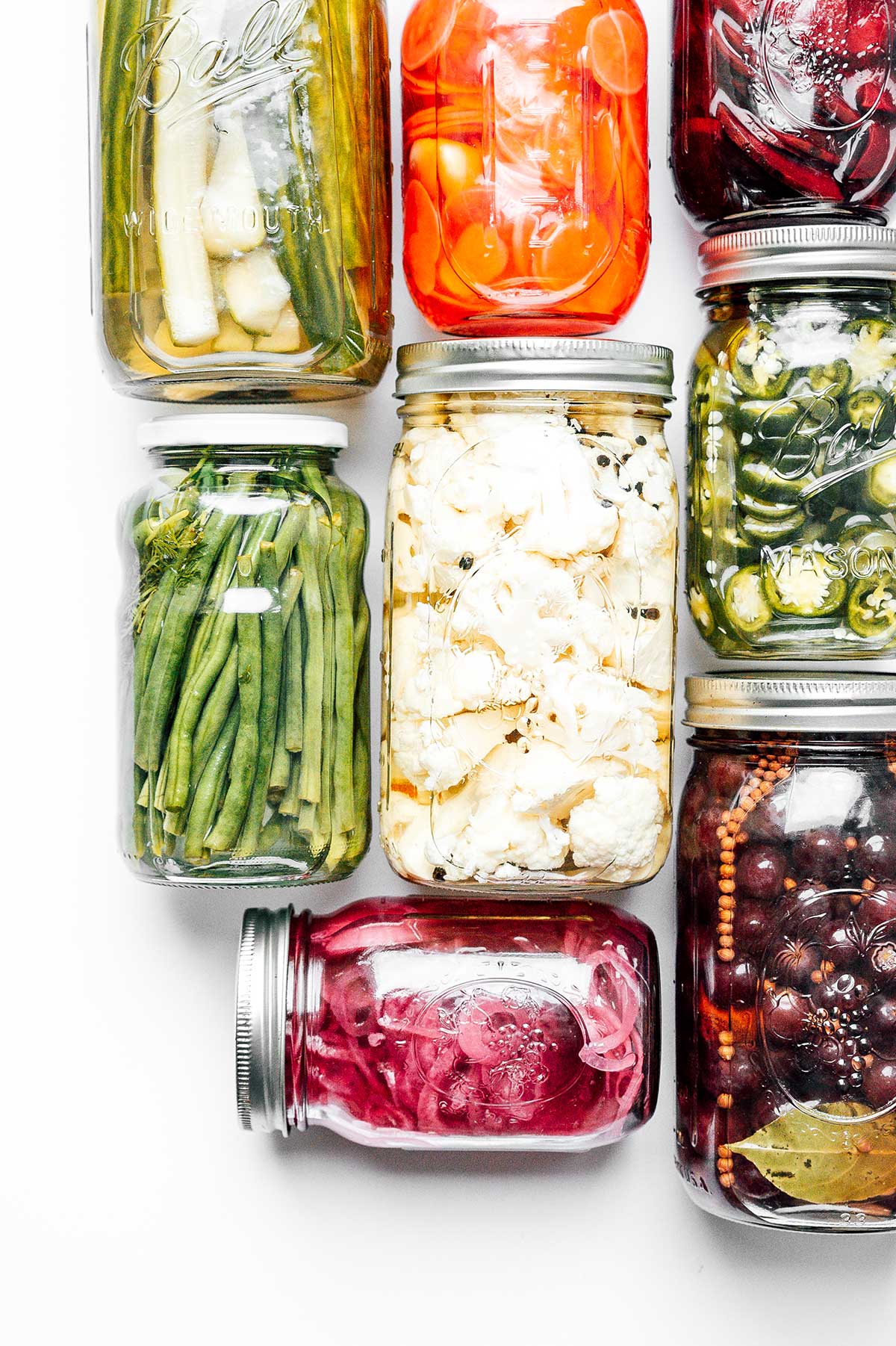
I always thought that pickling vegetables required a long and drawn out process. That is, until I actually tried it for myself. In all actuality, pickling vegetables is extremely easy, quick, and a great way of bringing new life to your veggies!
At this point I’ve pickled just about everything I can get my hands on, to include cabbage, jalapeños, onions, radishes, and of course cucumbers.
So to bring it all together, I’m sharing the ultimate guide to quick pickled veggies so that you have a comprehensive list of how to pickle anything you’d like!
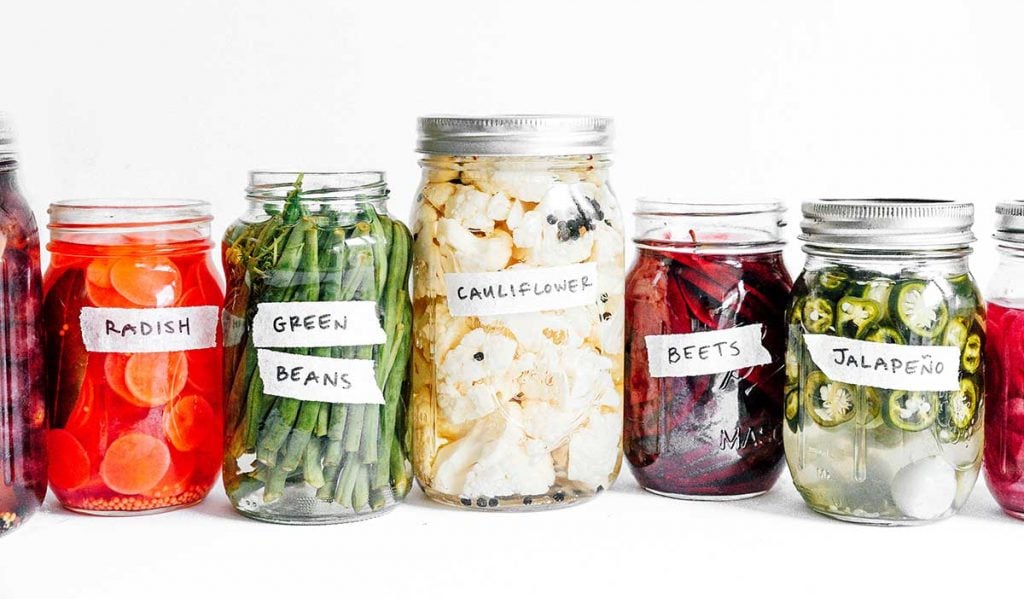
The basics of pickling
There’s a big difference between quick pickling and canning. Though they’re both the same concept – preserving vegetables – they’re very different.
Quick pickling involves brining and marinating, and allows for short term storage. It’s the method I’ve been using to make all of my homemade pickle recipes.
Canning, on the other hand, requires a stronger pickle brine and a hot water batch. This method allows for long term storage, but it’s a bit more technical and involved. It also requires specific steps in order to prep the food to stay edible for the long term.
It’s important to note that all of the recipes included in this post are quick pickling recipes that last for 2 to 3 weeks in the refrigerator. These recipes have not been tested for long term canning. Be sure to follow the best USDA canning practices if canning for long-term storage.

Veggies that can be pickled
Pretty much any vegetable that you can think of is able to be pickled. You can make quick pickled vegetables like cauliflower, squash, mushrooms, broccoli, or even asparagus!
Similarly, fruits also work! It may sound crazy, but trust me… they’re delicious. We’ve done pickled grapes, but you can also try pickled berries, melon, cherries, and peaches.
Pickling fruits and vegetables creates an acidic result that adds an interesting but delicious dimension to any recipe like tacos or salads. It brings new life to the pickled item, creating a completely new flavor while extending the shelf life.
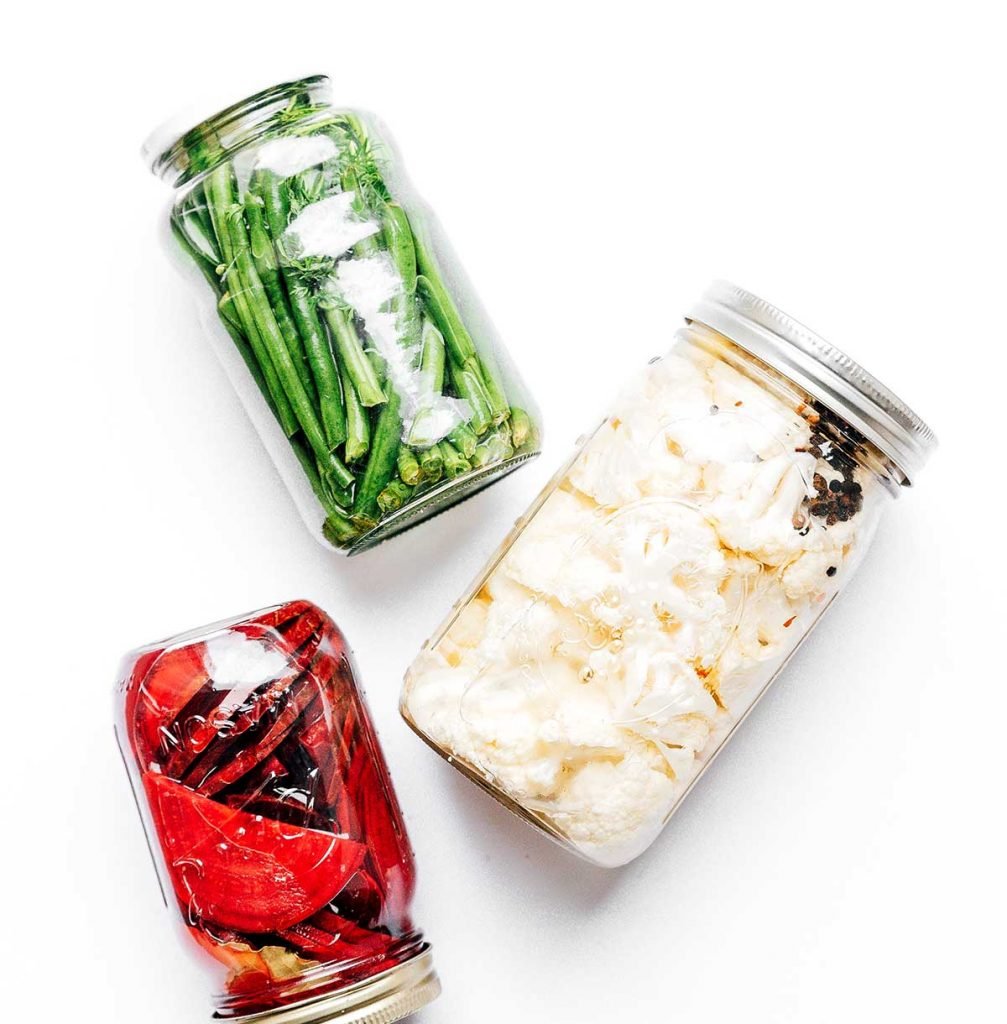
Ideas to get you started
Here are some of the pickled foods that I’ve created. They’re all very easy to make, with each one requiring right around 5 minutes of hands-on prep time.
Cauliflower: Pickled cauliflower utilizes 1 cup hot water, 2 tsp non iodized salt, 1 cup apple cider vinegar or white vinegar, 2 cups chopped cauliflower, 1 tsp whole black peppercorns, 2 cloves crushed garlic, and a pinch crushed red pepper flakes.
Green Beans: To make pickled green beans, you’ll need 1 cup hot water, 2 tsp non iodized salt, 1 cup apple cider vinegar or white vinegar, ½ lb (226 g) trimmed green beans, 5 to 10 sprigs (1 to 2 tsp chopped) fresh dill, and 2 cloves crushed garlic.
Beets: Pickled beets involve using 1 cup hot water, 2 tsp non iodized salt, 1 cup apple cider vinegar or white vinegar, 1 to 2 beets (diced or cut into half moons), a single tsp sugar, 1 bay leaf, and 1 clove of crushed garlic.
Jalapeños: To make pickled jalapeños, you’ll need 1 cup hot water, 2 tsp sugar, 2 tsp non iodized salt, 1 cup white vinegar, 10 to 15 jalapeños, 2 cloves crushed garlic, 1 bay leaf, a pinch cumin, and a pinch oregano. You can make these less spicy by removing the some of the jalapeño seeds.
Radishes: Pickled radishes require 1 cup hot water, 2 tbsp sugar, 2 tsp non iodized salt, ¾ cup white wine vinegar, ½ lb of radishes, 1 tsp mustard seeds, 1 clove of crushed garlic, 1 bay leaf, ½ tsp of crushed red pepper, and ½ tsp coriander seeds.
Cucumbers: Refrigerator pickles will require 2 pickling cucumbers (or 1 English cucumber), 1 cup apple cider vinegar or white vinegar, 1 cup water, 1 tsp non iodized salt, 10 sprigs (2 tsp chopped) fresh dill, 4 cloves crushed garlic, 1 bay leaf, 1 tsp whole black peppercorns, and a pinch crushed red pepper flakes.
Onions: Pickled onions simply require ½ cup hot water, 1 tbsp sugar or honey, 1 tsp non iodized salt, ½ apple cider vinegar, and 1 large thinly sliced red onion.
Cabbage: To make pickled cabbage, you will need ¼ of a red cabbage (sliced), ½ cup apple cider vinegar or red wine vinegar, ½ cup water, 1 tbsp sugar, 1 clove minced garlic, 1 tsp salt, and ¼ tsp ground black pepper.
Grapes: For pickled grapes (and most fruits), you will need 1 cup hot water, ½ cup sugar, 1 cup apple cider vinegar, 2 inches peeled and thinly sliced ginger, 1 tbsp coriander seeds, 1 tsp whole black peppercorns, 1 tsp mustard seeds, 2 cinnamon sticks, 1 bay leaf, and 2 to 3 cups of seedless red grapes.
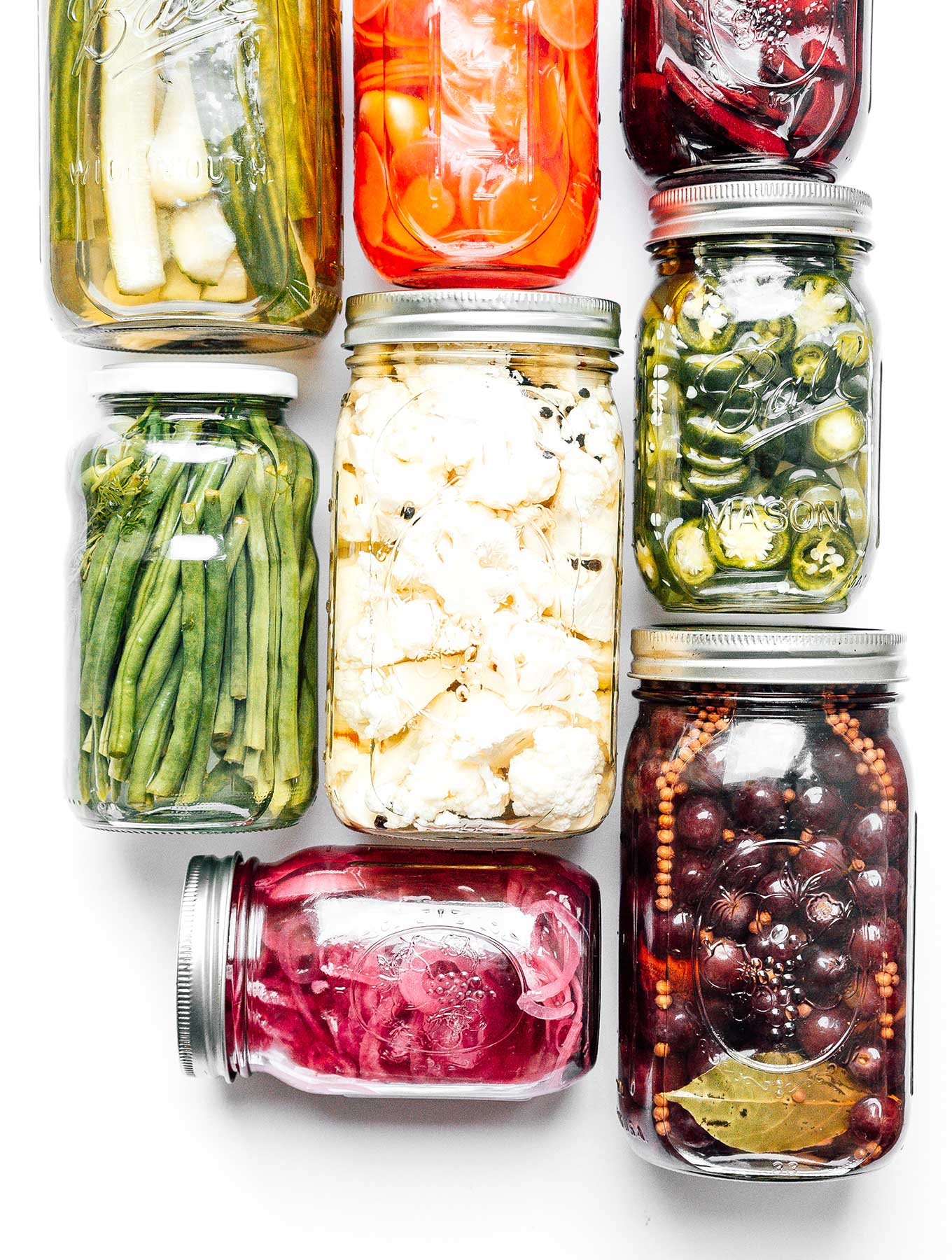
How to make quick pickled vegetables
Let’s get into the nitty gritty and talk about the steps required to bring pickled veggies to life. Here’s an easy 3-step method that I used to create my quick pickle recipes.
- Prepare the brine: First, heat water in either a kettle, the microwave, or on the stove until steaming hot. Stir in the salt until dissolved, and then stir in the vinegar. I like to add the vinegar last (as opposed to heating it up with the water) to help cool the brine faster. These are quick pickles after all!
- Pick your pickle: Choose your flavor, then add all of the ingredients to a lidded non-reactive container (like a glass jar or ceramic vessel). Pour the brine liquid over the ingredients and sure they’re covered. You may not use all of the liquid.
- Let it pickle: Next, let the jars and their contents cool to room temperature, then seal them shut and transfer them to the refrigerator. Let them pickle for at least one hour before digging in!
And there you have it! Delicious, easy, and quick pickled vegetables. I can’t wait for you to try them out. Enjoy!
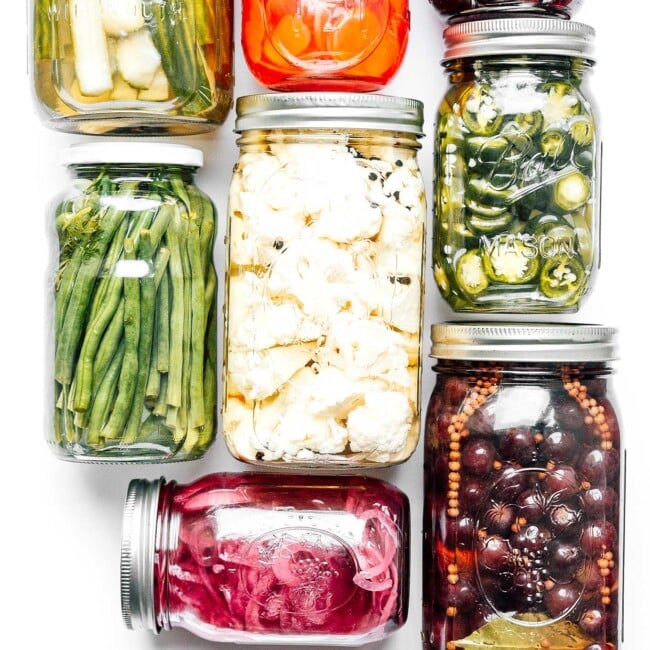
Ingredients
Pickling Brine
- 1 cup hot water 236 mL
- 2 tsp non iodized salt*
- 1 cup vinegar apple cider or white vinegar, 236 mL
Pickled Cauliflower
- 1 tsp whole black peppercorns
- 2 cloves garlic crushed
- Pinch crushed red pepper flakes
- 2 cups chopped cauliflower
Pickled Green Beans
- 5 to 10 sprigs fresh dill about 1 to 2 tsp if chopped
- 2 cloves garlic crushed
- ½ lb green beans trimmed, 226 g
Pickled Beets
- 1 tsp sugar
- 1 bay leaf
- 1 clove garlic crushed
- 1 to 2 beets diced or cut into half moons
Instructions
- Brine: Heat water in either a kettle, the microwave, or on the stove until steaming hot. Stir in salt until dissolved. Stir in vinegar.
- Pick Your Pickle: Choose your flavor, then add all of the ingredients to a lidded non-reactive container (like a glass jar or ceramic vessel). Pour liquid over ingredients so that they are covered (you may not need all of the liquid).
- Pickle: Let cool to room temperature, then seal shut and transfer to the refrigerator. (Let pickle for at least 1 hour before digging in.)
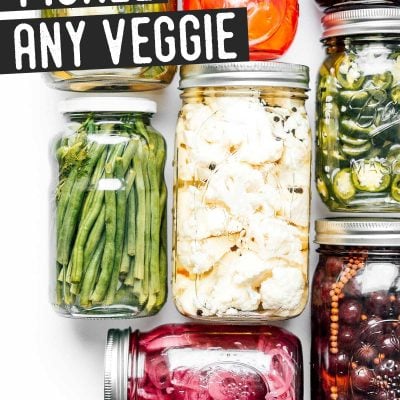
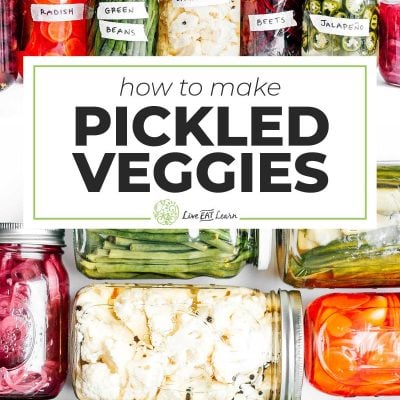
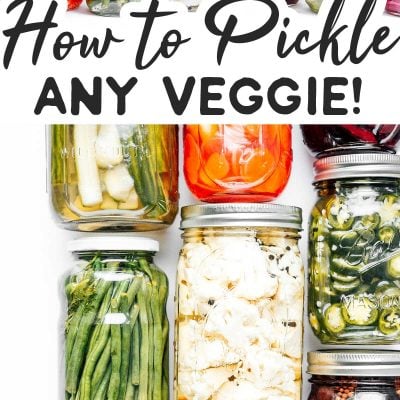
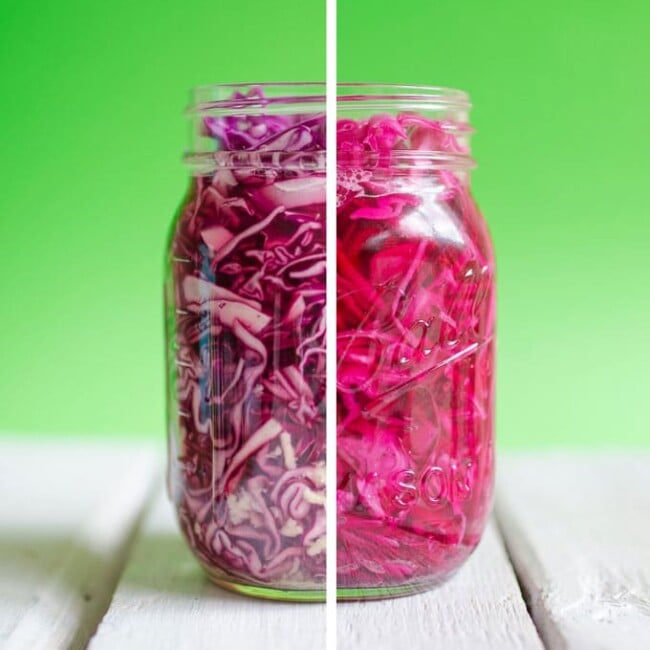
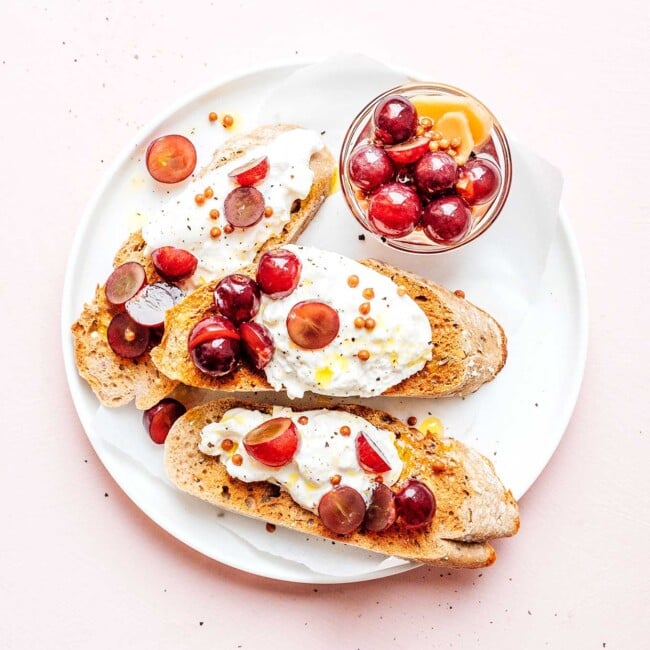
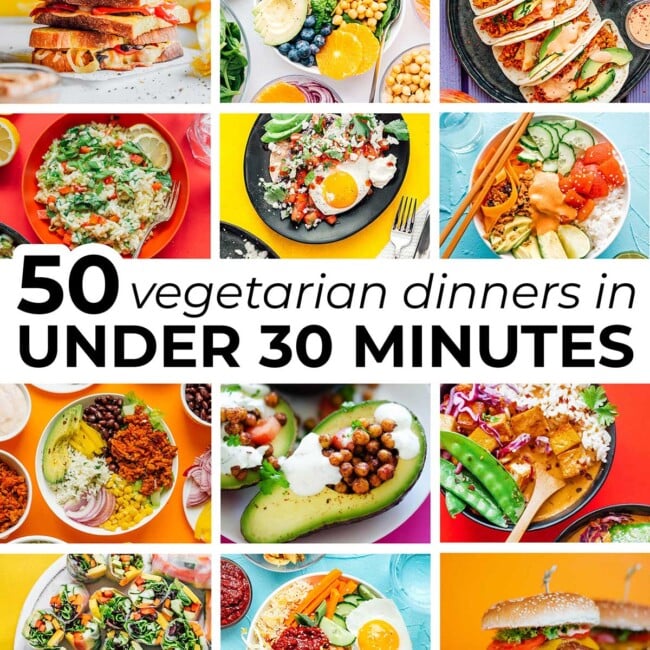
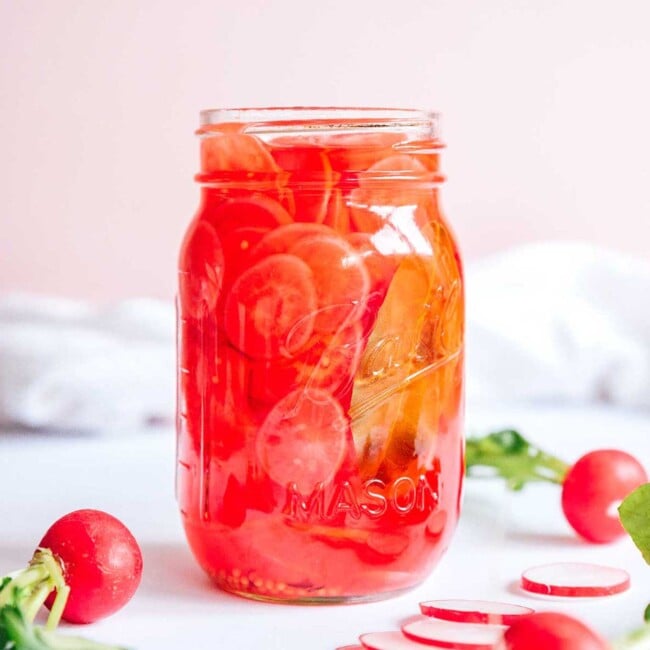
Sally Wilson says
I have just pickled raw pumpkin, carrots and onions together. Thats all the vegetables I had left in fridge. I spiced with bay leaves, black pepper, chilli flakes, cardamon pods, coriander seeds and garlic flakes. (Didnt have fresh) Absolutley delicious. Also added a little bit of honey.
Sarah says
This sounds AMAZING! Thanks for the ingredient ideas! 😀
Carolyn K Jamkhandi says
I tried this method with baby carrots, onions and hot peppers cut in half and they are delicious. Going to make more this evening.
Sarah says
YUM! This sounds so delish. Enjoy!
ashley says
These recipes look delicious! I’ve been wanting to explore the different options when it comes to pickling. I can’t wait to try. Thank you for sharing!
Mammie says
Keep up thee great work, I read few content onn this web site and I think that
your web siite is really interesting and holds lots of excellent
info.
Stephen Ruffino says
Can I use kosher salt and if so are the proportions the same?
Sarah says
Yep you can, but the proportion is not the same. Use a chart like this to figure out the amount you’ll need! 😀
Tina wood says
Hello
I love your quick pickle recipe.
I love the idea of pickled fruit, any suggestions what fruits other than grapes you could use?I
Thank you in advance. Xx
Sarah says
Any kind of berry (blackberries, blueberries, strawberries) or stone fruits (like cherries and plums) would be delish! 😀
Michelle says
Pickled Peaches are delicious! I know it sounds weird, but trust me on this one! I had these back in Georgia and OMG! So so good.
Jeannette Odom says
Are these recipes for 1 qt only?
Sarah says
Yes, approx!
Jean vetter says
Can you reheat the used brine and use it again with a different veggie?
Sarah says
Yep that should be fine! 😀
Paul Arthur Hastings says
Reserve any juice from any jar of pickles (Mt. Olive w/Sea Salt) Cut veggies rotate and swish jar for 2 days. Don’t dump all that goodness down the drain. Let Corporate America do the work for you !!
Scott says
Can I pickle eggplant the same way?
Sarah says
While I haven’t tried this out myself, I think it could work!
Eric V. says
Nomnom thanks
Marie rhone says
Fantastic!!! Is all I have to say.
Kathryn says
Hi, great page, thanks!
I’m just wondering why the salt needs to be non-iodised?
Sarah says
Iodine can impact the color and flavor when pickled! 😀
rakes endures says
Another possible reason: My sister (a protein chemist) says non-iodized salt doesn’t absorb sulfur from the vegetables – our liver apparently needs that sulfur.
Jean says
Hi… I see you recommend putting the pickled veg in the fridge. I’m wanting to pickle veg as a back up in case our electricity grid collapses… Which will then mean no electricity… No fridge. Will pickles keep for a few weeks in a cool, dark room?? Thanks. Jean.
Sarah Bond says
Hi Jean! These are for quick pickling – for longterm storage you’ll need to follow a guide for longterm pickling (the salt ratios will be different and they may require a water bath).
HE CA says
Can I ommit/skip the SALT?
THANK YIU!
Sarah Bond says
You really do need the salt for this one for the pickling process / flavor!
BeverleyM says
Hi there, you’re missing the measurement of beans “½ (226 g) trimmed green beans” — I can do it in grams of course but was that meant to be 1/2 cup? 1/2 pound? 1/2 bushel? 🙂
Sarah Bond says
Thanks for pointing that out! It should be 1/2 lb 😀
Rose says
I pickle celery. Keeps longer and I use it in salads
I also do onions
ben says
Hello……if the package or jar of salt does NOT say contents are iodized, are we safe to assume that it is not? Thanks……a pickled Canadian !
Sarah Bond says
Yep, that should be fine! 😀
Jo says
I cut onion, courgette, carrot and green beans, placed in a roasting tin with mange tout. Covered with foil and roasted at 200C for 10 minutes. Added the boiling water, vinegar, salt, allspice berries and crushed garlic clove. Recovered with foil and left in a cold place before going in a jar in the fridge to chill. It was gorgeous!!
Medana Crow says
Can I pickle okra using this method? If so, what optional ingredients can I add?
Sarah Bond says
Yes! You could add garlic and/or dill 😀
Lori says
I see some recipes add sugar (like for beets). Do I have to add sugar?
Sarah Bond says
You don’t need to, it’s just for flavor!
Cynthia Muse says
Can you pick a cantaloupe watermelon oranges mangoes pineapple coconut
Sarah Bond says
I haven’t tried pickling these fruits so I can’t say for sure!
Brian York says
How long do you have to let them refrigerate before the flavor sinks in? I’m primarily pickling cucumbers and green beans.
Brian
Sarah Bond says
At least 1 hour! 😀
Patricia cimakasky says
Great and easy instructions. I made pickled beets and pickles I’m not done yet will try Fruits. Thank you
Ted Purdy says
Delish
Charlotte says
Hi!
First time pickler here, have just made a jar of your pickled red cabbage and red onion.
Possibly a silly question here, do you have to cook the beetroot before pickling?
Sarah Bond says
You do not! 🙂
Monica Rodrigues says
Do you have to use hot water for the brine? I’ve only ever used cold. I didn’t realize I should be using hot.
Sarah Bond says
You can use either! Hot water will just pickle them quicker.
mindy engle says
Hi! I’m diabetic and also on a low sodium diet. Can I make these without the salt? Thanks.
Sarah Bond says
You can, but they might not last quite as long due to the low salinity.
Max Manderlay says
At least an hour? Try at least a couple of weeks. Else it ain’t pickled. It tastes of vinegar. Big difference.
Sarah Bond says
This is a recipe for *quick* pickling, which is different from the traditional pickling you’re referring to.
Janice Hall says
How about pickling garden fresh green tomatoes? I had them as a kid and loved them . Even better than dill pickles. How would you suggest doing them?
Sarah Bond says
To pickle green tomatoes I would do the same proportions of water/vinegar/salt listed here, using white vinegar and maybe some bay leaves!
Laura Navarro Cobos says
Looks delicious and easy
Tammy says
Is this considered a lacto-ferment process? It sort of seems like it could be if you let the jar on the counter for a few days.
Sarah Bond says
This is not, this is considered “quick pickling”. You’ll have to double check the sugar and salt ratios if you’re doing a lacto-fermented pickle! 😀
Jane Cunningham thrift says
Have you ever quick pickled green tomatoes? If so what recipe did you use?
Sarah Bond says
I haven’t but I think this recipe would work well!
Annie choi says
do you need to cook the vegetables before jarring them with the brine? Or can you quick pickle them raw? TIA!
Sarah Bond says
You can pickled the veggies raw! 😀
Ron says
Your recipes do not specify the amount of each vegetable to use for the amount of brine. A weight or other measure of the primary ingredient is really necessary to proportion the other ingredients.
I appreciate your work, but we need a little more info.
Thanks